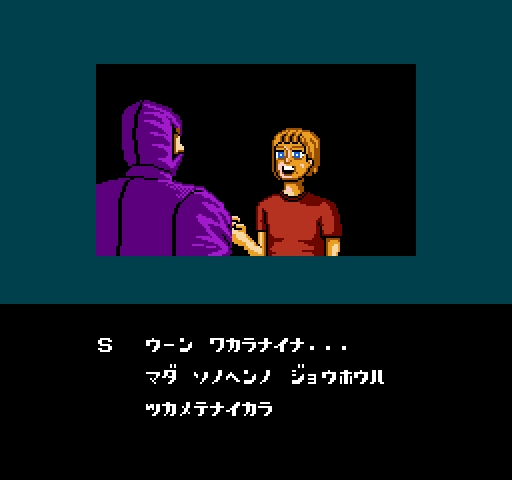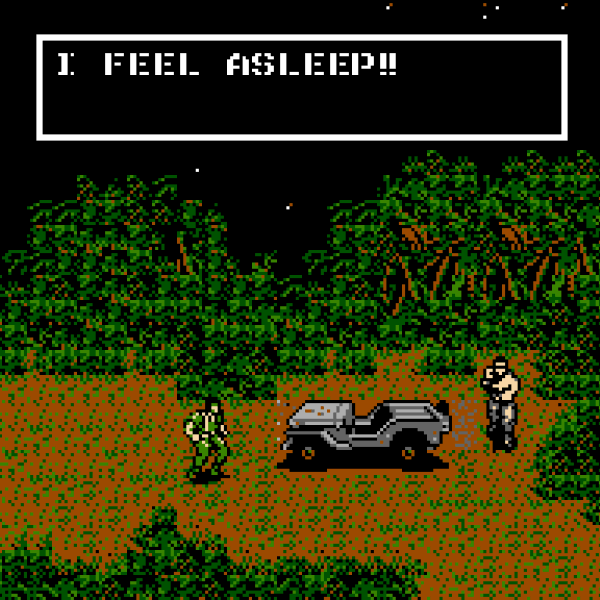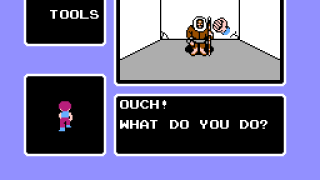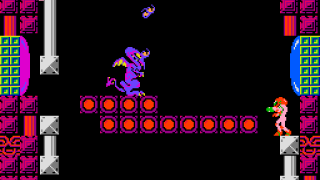A reader recently asked about an old NES game I hadn’t thought about in years: Wrath of the Black Manta.
At one point in the game, the main character – who’s a ninja – tells a kid about drugs and how drugs are bad.
 |  |
| Ninja Cop Saizō (Famicom) | Wrath of the Black Manta (NES) |
So, was this anti-drug message secretly added into the game, or does the original Japanese game feature an anti-drug ninja too?
Let’s take a look at the scene side-by-side:
| Japanese Version (basic translation) | English Version |
| Kid: You saved me, mister! I wonder why they kidnapped me, though… My family isn’t especially rich or anything. Maybe they made a mistake… | Kid: Geez, thanks for letting me out. Why did they kidnap me? My family isn’t rich or anything. |
| Ninja: Hmm, I’m not sure. I don’t have much information to go on yet. Do you know of a kid named Sasuke? | Ninja: It seems to be drug related. You don’t use drugs, do you? |
| Kid: Nope! | Kid: No, I don’t. |
| Ninja: Oh, okay, then. This place is dangerous. Hurry and get out of here. | Ninja: Good. Don’t let anyone get you started on drugs. They’re a dead end. |
Wow, those are some serious changes! If you’d like to see both versions of the above scene in action, I put together a video of them here:
I wonder who decided to insert this anti-drug text and why – surely there was some sort of conversation or meeting that sparked the decision. I’d love to get in touch with anyone who worked at Taito at the time!






We know the infamous WINNERS DON’T USE DRUGS screen in ’90s arcade games.
So I read that inclusion of that screen was mandated on all imported (not American-developed) arcade games.
But this wasn’t an arcade game. Hmm…
Funny, the kid in the localized version doesn’t even look like a kidnapping victim. He’s so smug, like he’s the one behind the kidnapping!
By the way, Mato, did you thank Obama for this request? 😀
(that is such an overused Poke-joke)
This isn’t related to the thing at handed, but I’ve remembered something. In the game Paper Mario: The Thousand-Year Door, a character named Doopliss steals Mario’s identity. To get it back, you have to guess his name; unfortunately, he has taken the lower-case p out of the text input screen, and his name is assuredly not DooPliss. Do you think you could look into this in Japanese? This takes place in Chapter 4 of the game.
Doopliss’ Japanese name is Rumple (ランペル), therefore the “m” in his name (ん/ン) would be removed from the name input screen. So the player could only type out “Ruple” (ラペル). You can see a video where a guy points out where the “m” (ん/ン) is supposed to be: http://www.youtube.com/watch?v=J6D1AVNKXCQ&t=2m49s
So you have to hunt out the 『ン』のもじ (The character “m”) in order to spell his name.
Does the Japanese version make it possible for you to use the hiragana “n” in “Rumple”, but he can somehow hear the difference between hiragana and katakana?
The hiragana n is missing in that video too, so no.
That’s a little weird, because in English, if you use uppercase P, he says that’s not his name
Obviously the message wasn’t be in the Japanese version because the Japanese treat drug abuse very seriously. Let’s just say that if you’re famous or work in a major occupation in Japan and then decide to do drugs at some point, chances are no one in will want anything to do with you and will do everything they can to disassociate themselves from you.
Fat lot of good slipping in those “don’t do drugs” messages did anyway; substance abuse is a regular fact of life here.
But if Japanese society takes drug abuse more seriously, wouldn’t that make the message MORE likely to appear in a Japanese work?
Their kids don’t require anti-drug messages, especially since video games were considered children’s entertainment for many years. Drugs are apparently only an adult problem there.
It’s also a college student problem; yakuza specialize in crystal meth (“shabu”) which is used to keep you awake.
*wouldnt be
*wouldn’t be
I saw the title and assumed at first that it had something to do with a certain Aquaman villain 😀
Also, I just got back from a week-long vacation with my family in florida, and i brought the Zelda book with me and read it during the long car drive down there. Very well done, Mato.
Wait, what about the Sasuke kid? I suppose he´s important for the plot, that´s why he´s asking about him. Did the plot change so much in the English version? I´ve never played this one, but now I´m curious about the differences too :p
Interesting as always, Mato. I hope 2016 be a great year for Legends of Localization.
Surprisingly, aside from the anti-drug message, not a lot really was changed plot and story wise from the Ninja Cop Saizou. However, not because I am from the USA, I actually find the anti-drug thing a BETTER addition to the storyline because if you saw what Ninja Cop Saizou looked like in comparison to Wrath of the Black Manta, some of those bosses that got changed honestly were changed for the better in the USA, but it is a shame that the Stage 2 and 3 bosses, let alone all of Stage 2, was cut out from Wrath of the Black Manta.
It doesn’t seem like this scene serves much purpose in the first place (the kid doesn’t give any clues to Sasuke’s whereabouts), so the translator thought it wouldn’t be an issue to change it into an educational message. At least it makes the scene more memorable 🙂
Remember, don’t do drugs or else a Ninja will come and stabs you! Ins seriousness, I have never heard of this game before. How does it play for example?
Am I the only one who thinks it is weird that they willingly change the text so much?
This reminds me of a non-game example of forcing an anti-drug (more specifically an anti-smoking one) message in an anime. A *children’s* anime, might I add, one that is otherwise extremely family-friendly, and was once broadcast Saturday mornings where all the kids will see (IIRC right next to Digimon). Kind of like a inverse 4Kids approach, come to think of it.
There was this one episode of Flint the Time Detective (I believe it’s the one with the Cardians) where in the English dub a man gets called out for smoking, and he was so reluctant to quit the act after being bogged down about it from a girl (and the main characters), and after that it was never brought up again for the rest of the episode. In the Japanese script, there was not even so much as a mere MENTION of smoking, he just was holding a cigarette in the shot. It’s normally standard procedure in dubbed kids anime broadcast in American network television to just airbrush the cigarette out and any smoke that comes out of it (or in the case of 4Kids One Piece’s Sanji, replace it with a lollipop) due to some FCC regulation nonsense and such, as well as “think of the children!!”, since the cigarette is usually only for show and not relevant to the overall plot anyway, but not in this case.
The cartoon was broadcast in America in 2000, in which I believe anti-tobacco-smoking campaigns and ads from non-profit agencies were increasingly more common than ever, especially on children’s television, but even so, that was a bit awkward, forcing a message like that where it didn’t originally exist.
Makes me miss the good old days, when issues in the animation would just be “corrected” in the dialogue. The old, original Pioneer dub of Dragon Ball Z was awesome this way; whenever anybody got killed — for instance, when Nappa gets bored waiting for Goku and decides to pass the time by murdering people — there would be a voice overlay of a news broadcaster saying something like “thank goodness nobody was hurt!”
Ever see the G.I. Joe movie — the cartoon from the 80s, I mean? That had the best example I’ve ever experienced. There’s a major character who gets killed during the movie, and then the ending has a bit of a sad scene where the other characters reflect on his passing. But the death of Optimus Prime in the previous year’s Transformers movie wasn’t well received by the audience, so the studio was instructed to change it after the animation had already been done. So they rerecorded the dialogue in the ending scene to be everybody cheering the news that he’s just been released from the hosiptal and is going to be just fine; trouble is they obviously have miserable looks on their faces.
Normally, I would chalk it up to that, but the licensors of the anime, Saban, have definitely shown to be capable of airbrushing out a lot of on-screen stuff, in the anime I mentioned and a lot other stuff that they have or had the rights to, like Digimon. They even digitally painted over a lot of scenes from their recent “adaptation” of Smile Precure, or should I say, Glitter Force. Though most of Saban’s airbrushing is usually done to on-screen Japanese or even Engrish text, not much else, which is a bit better than 4Kids.
If they are fully capable of editing out/changing huge chunks of Japanese text in the backgrounds, then I don’t see how editing out a really tiny cigarette (or adding a candy-like circle to one end of it to make a lollipop) to comply by FCC standards of television aimed at minors is any issue for them. By no means am I condoning the act of censoring anime visually a whole lot to the point of “ruining” it, but it’s definitely better than the stupid alternative they took.
Can you do a comparison of Dr. Robotnik’s infamous “Snooping as usual, I see!” and “I’ll have to give myself a PROMOTION!” lines from Adventures of Sonic the Hedgehog?
Adventures of Sonic the Hedgehog was made in English to begin with.
The show does not have a Japanese incarnation of itself. He would have to use languages other than Japanese if he were to do a comparison.
Ah, Wrath of the Black Manta. I have strangely fond memories of this game from my childhood. I’ve played through the Japanese version of the game (Ninja Cop Saizou), and even being unable to read any of it I can tell its plot is completely different. Not to mention a couple of levels and bosses got cut from the American version, the soundtrack was totally changed, some of the special moves got shuffled around, and a completely different final boss was cooked up to match the new plot. I would definitely be interested in knowing what the original game was all about. Both games are pretty darn obscure, though…